Achieving High Self-Lubricating Performance of Al-Bi-Sm-Ti Alloys Based on the Intermetallic Compounds
Abstract
1. Introduction
2. Experimental Procedures
3. Results and Discussion
3.1. Microstructure
3.2. Properties
3.3. Solidification Microstructure
4. Conclusions
Author Contributions
Funding
Data Availability Statement
Acknowledgments
Conflicts of Interest
Correction Statement
References
- Zhao, D.G.; Liu, R.X.; Wu, D.; Bo, L.; Wang, L. Liquid-liquid phase separation and solidification behavior of Al-Bi-Sb immiscible alloys. Results Phys. 2017, 7, 3216–3221. [Google Scholar] [CrossRef]
- Zhou, B.; Lin, W.; Guo, Y.; Zheng, T.; Zhong, Y.; Zhang, L.; Zhang, Q. Tailoring homogeneous immiscible alloy via magneto-Archimedes levitation. Scr. Mater. 2023, 226, 115268. [Google Scholar] [CrossRef]
- Sun, X.; He, J.; Chen, B.; Zhang, L.; Jiang, H.; Zhao, J.; Hao, H. Microstructure formation and electrical resistivity behavior of rapidly solidified Cu-Fe-Zr immiscible alloys. J. Mater. Sci. Technol. 2020, 44, 201–208. [Google Scholar] [CrossRef]
- Verma, N.; Pant, N.; Beach, J.A.; Ivanisenko, J.; Ashkenazy, Y.; Dillon, S.; Bellon, P.; Averback, R.S. Effects of ternary alloy additions on the microstructure of highly immiscible Cu alloys subjected to severe plastic deformation: An evaluation of the effective temperature model. Acta Mater. 2019, 170, 218–230. [Google Scholar] [CrossRef]
- Jiang, H.; Li, S.; Zhang, L.; He, J.; Zhao, J. Effect of microgravity on the solidification of aluminum-bismuth-tin immiscible alloys. NPJ Microgravity 2019, 5, 26. [Google Scholar] [CrossRef]
- Xie, M.; Zhou, S.; Zhao, S.; Jin, J.; Chen, D.; Zhang, L.C. In-situ Fe2P reinforced bulk Cu-Fe immiscible alloy with nanotwinned Cu produced by selective laser melting. J. Alloys Compd. 2020, 838, 155592. [Google Scholar] [CrossRef]
- Deng, C.; Jiang, H.; Zhao, J.; Zhang, L.; He, J. Thermodynamics and solidification kinetics of Ag-Ni-Co immiscible alloys. J. Mater. Sci. 2021, 56, 3455–3471. [Google Scholar] [CrossRef]
- Peng, Y.L.; Wang, Q.; Wang, N. A comparative study on the migration of minor phase globule in different-sized droplets of Fe-58wt%Sn immiscible alloy. Scr. Mater. 2019, 168, 38–41. [Google Scholar] [CrossRef]
- Zhou, S.; Xie, M.; Wu, C.; Yi, Y.; Chen, D.; Zhang, L.C. Selective laser melting of bulk immiscible alloy with enhanced strength: Heterogeneous microstructure and deformation mechanisms. J. Mater. Sci. Technol. 2022, 104, 81–87. [Google Scholar] [CrossRef]
- Costa, T.A.; Freitas, E.S.; Dias, M.; Brito, C.; Cheung, N.; Garcia, A. Monotectic Al/Bi-Sn alloys directionally solidified: Effects of Bi content, growth rate and cooling rate on the microstructural evolution and hardness. J. Alloys Compd. 2015, 653, 243–254. [Google Scholar] [CrossRef]
- Wu, Y.; Su, J.; Zhang, L.; Du, M. Observations and simulations for phase separation process of immiscible Fe50Sn50 alloy droplets placed on a chilling surface. J. Alloys Compd. 2023, 947, 169565. [Google Scholar] [CrossRef]
- Zhao, B.; Zhang, L.; Wu, M.; Li, S.; Zhai, Q.; Gao, Y. Heterogeneous nucleation of embedded droplets in the Zn-15Bi immiscible alloy studied by nanocalorimetry. Thermochim. Acta 2023, 720, 179420. [Google Scholar] [CrossRef]
- Li, Y.; Xia, W.; Wang, X.; Ju, Y.; Liu, T.; Zhao, D.; Zuo, M. Effects of cooling rate on the microstructure control and liquid–liquid phase separation behavior of Cu-Fe-P immiscible alloys. Mater. Today Commun. 2022, 33, 104300. [Google Scholar] [CrossRef]
- Cao, S.; Lu, W.; Hu, Q.; Yu, P.; Ge, X.; Lai, P.; Li, J. Atomic tuning effect of TiB 2 particles on the liquid phase separation behavior of an Al-Bi immiscible alloy. Scr. Mater. 2022, 209, 114365. [Google Scholar] [CrossRef]
- Chen, L.Y.; Xu, J.Q.; Choi, H.; Konishi, H.; Jin, S.; Li, X.C. Rapid control of phase growth by nanoparticles. Nat. Commun. 2014, 5, 3879. [Google Scholar] [CrossRef]
- Cao, C.; Chen, L.; Xu, J.; Zhao, J.; Pozuelo, M.; Li, X. Phase control in immiscible Zn-Bi alloy by tungsten nanoparticles. Mater. Lett. 2016, 174, 213–216. [Google Scholar] [CrossRef]
- Sun, Q.; Jiang, H.; Zhao, J.; He, J. Microstructure evolution during the liquid-liquid phase transformation of Al-Bi alloys under the effect of TiC particles. Acta Mater. 2017, 129, 321–330. [Google Scholar] [CrossRef]
- Peng, Y.L.; Han, S.X.; Tian, L.L.; Wang, N. In situ investigation of minor-phase globule collision and the structure in a droplet-shaped immiscible alloy. Mater. Lett. 2019, 254, 222–225. [Google Scholar] [CrossRef]
- Wei, C.; Wang, J.; He, Y.; Li, J.; Beaugnon, E. Influence of high magnetic field on the liquid-liquid phase separation behavior of an undercooled Cu-Co immiscible alloy. J. Alloys Compd. 2020, 842, 155502. [Google Scholar] [CrossRef]
- Ratke, L. Coarsening of liquid Al-Pb dispersions under reduced gravity conditions. Mater. Sci. Eng. 1995, A203, 399. [Google Scholar] [CrossRef]
- Kaban, I.G.; Hoyer, W. Characteristics of liquid-liquid immiscibility in Al-Bi-Cu, Al-Bi-Si, and Al-Bi-Sn monotectic alloys: Differential scanning calorimetry, interfacial tension, and density difference measurements. Phys. Rev. 2008, 77B, 125426. [Google Scholar] [CrossRef]
- Zhang, L.; Man, T.; Huang, M.; Gao, J.; Zuo, X.; Wang, E. Numerical Simulation of Droplets Behavior of Cu-Pb Immiscible Alloys Solidifying under Magnetic Field. Materials 2017, 10, 1005. [Google Scholar] [CrossRef] [PubMed]
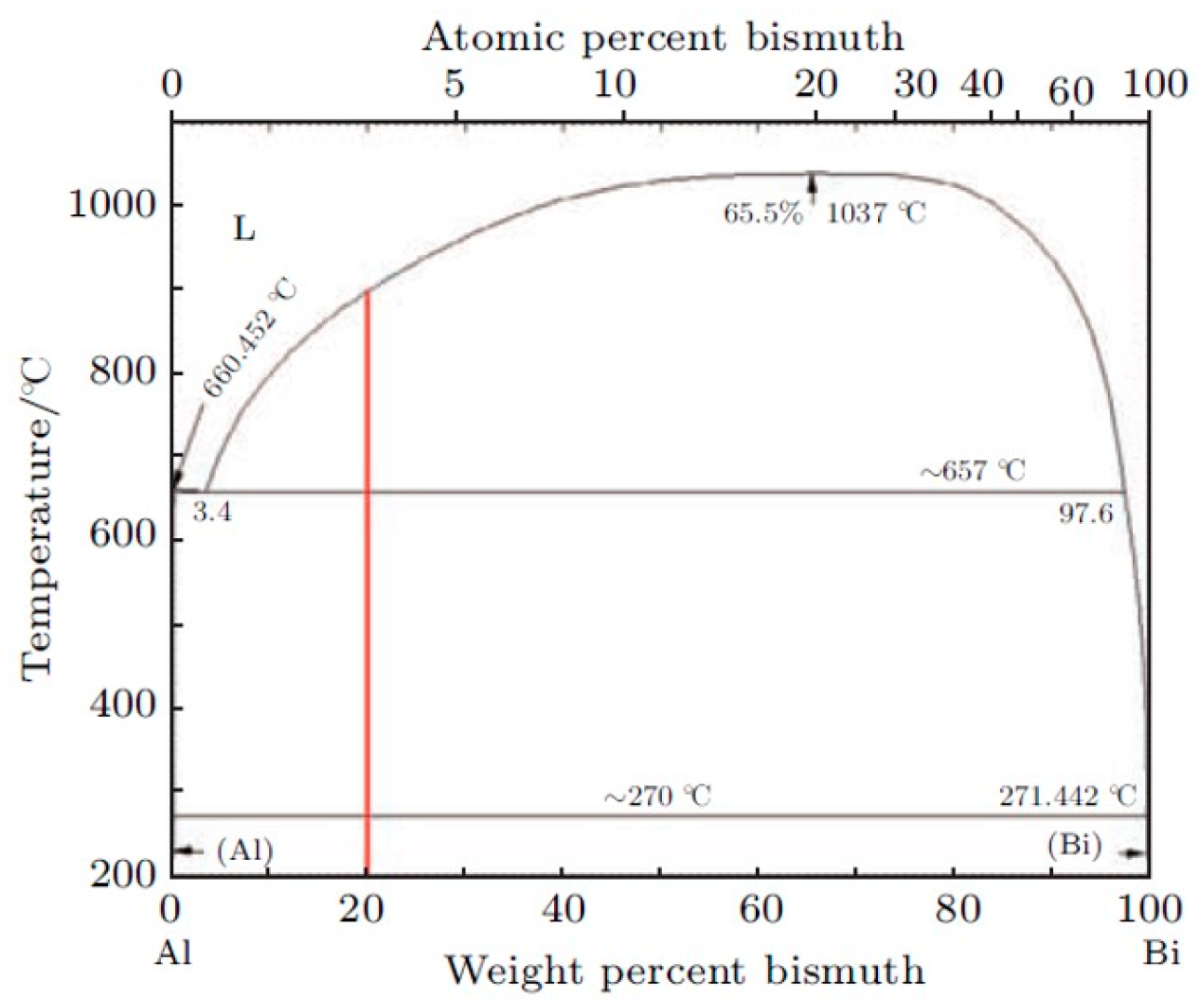
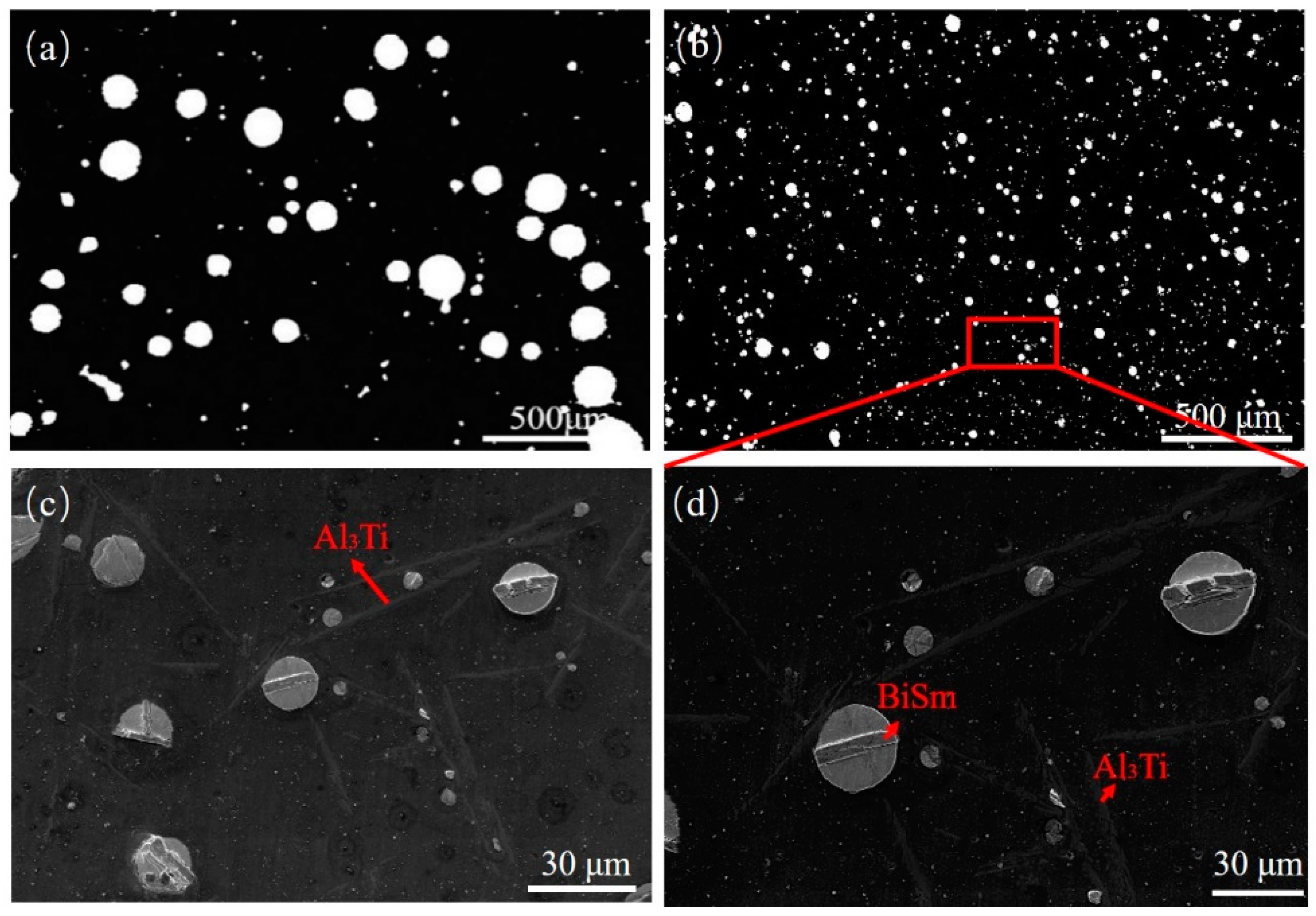
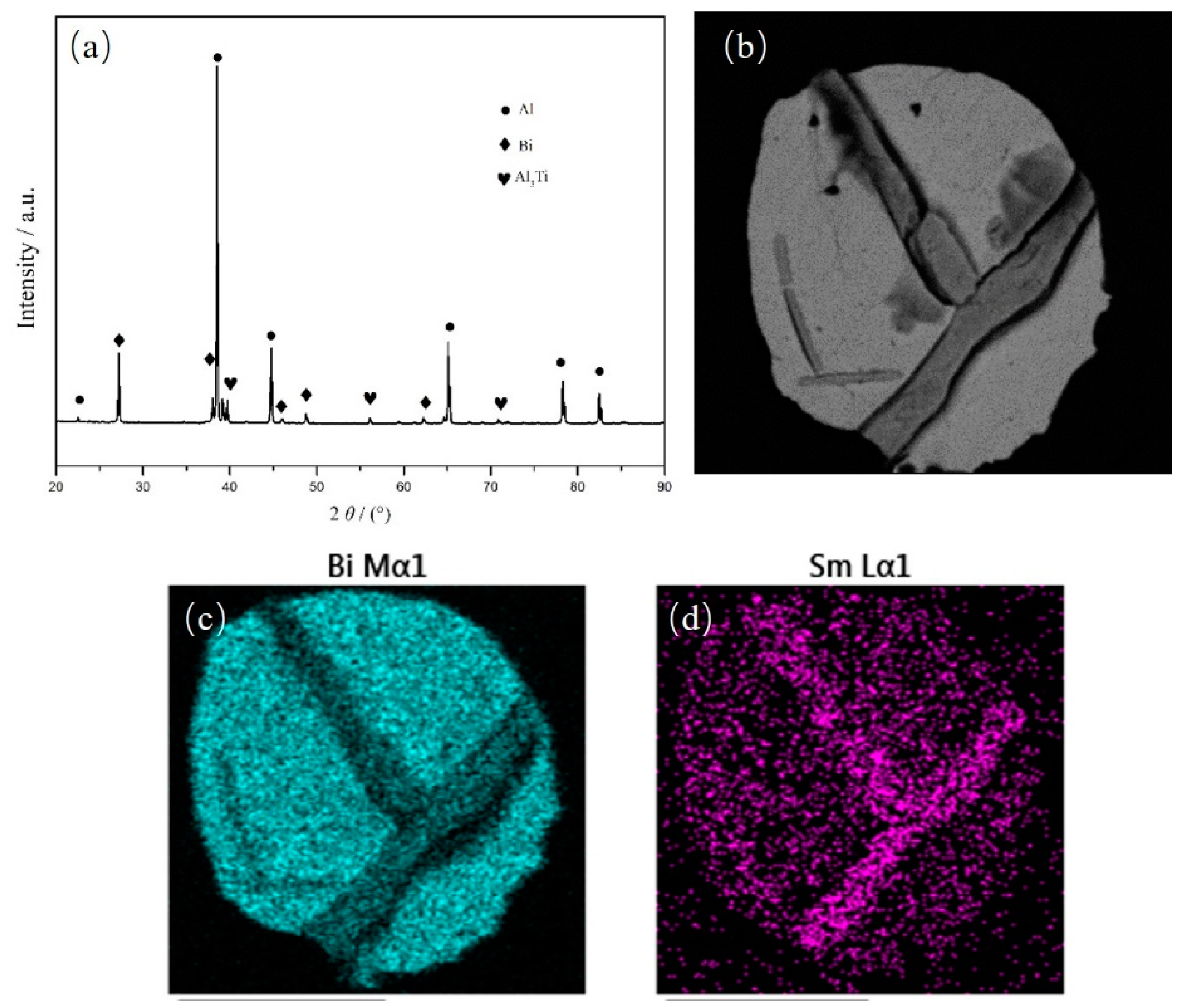

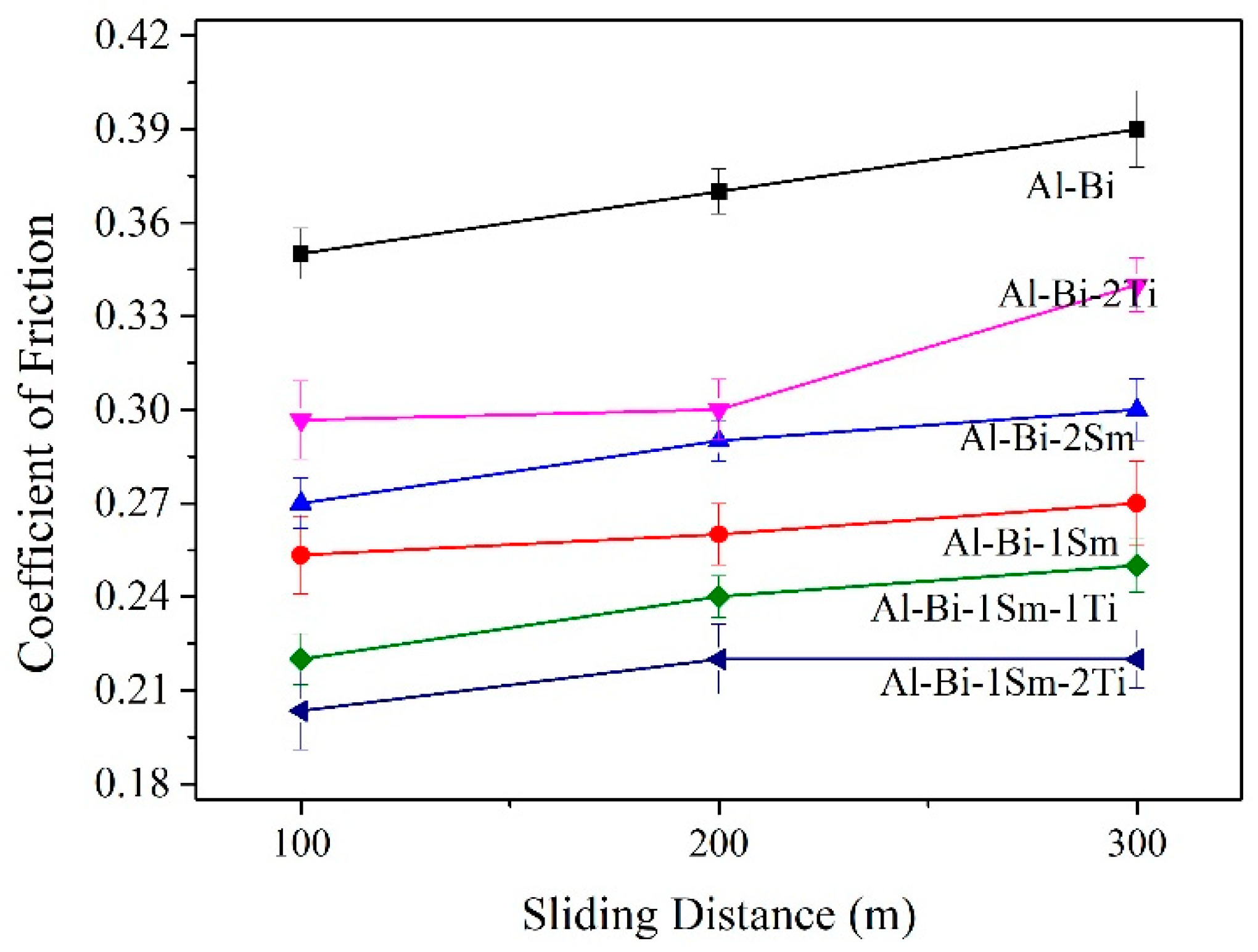
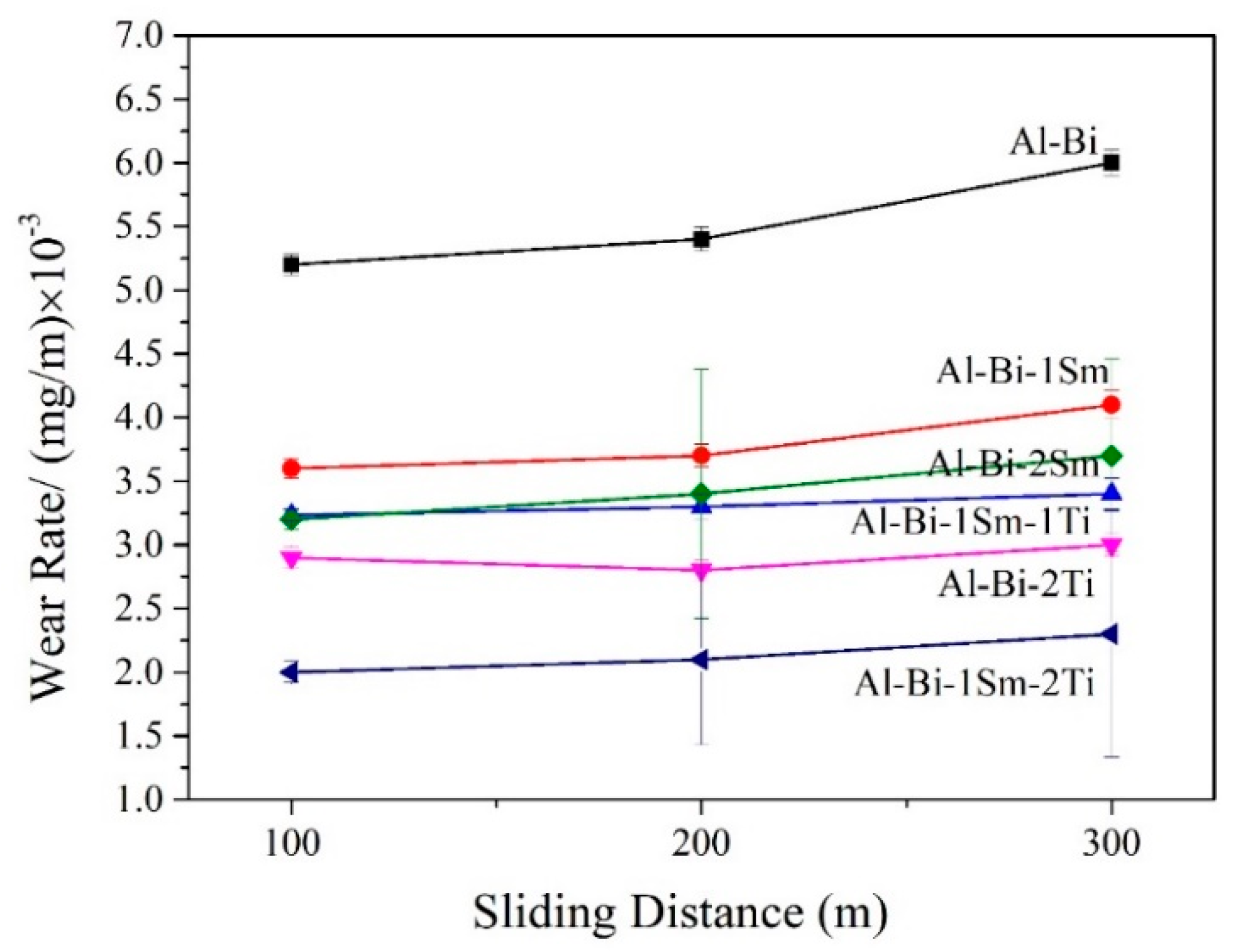

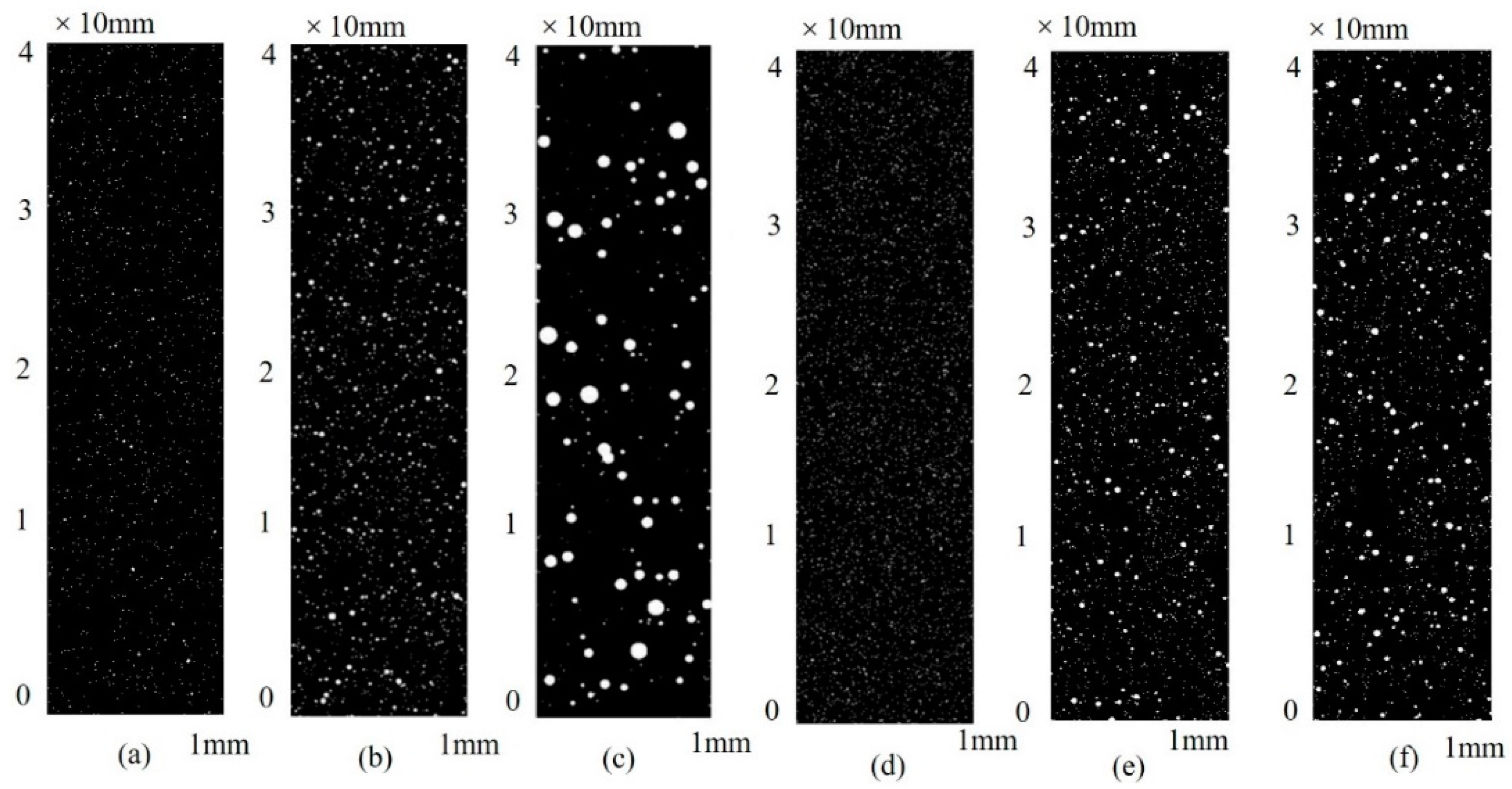
Disclaimer/Publisher’s Note: The statements, opinions and data contained in all publications are solely those of the individual author(s) and contributor(s) and not of MDPI and/or the editor(s). MDPI and/or the editor(s) disclaim responsibility for any injury to people or property resulting from any ideas, methods, instructions or products referred to in the content. |
© 2023 by the authors. Licensee MDPI, Basel, Switzerland. This article is an open access article distributed under the terms and conditions of the Creative Commons Attribution (CC BY) license (https://creativecommons.org/licenses/by/4.0/).
Share and Cite
Man, T.; Zhang, L.; Nong, Z.; Lu, S.; Wang, E. Achieving High Self-Lubricating Performance of Al-Bi-Sm-Ti Alloys Based on the Intermetallic Compounds. Metals 2023, 13, 1836. https://doi.org/10.3390/met13111836
Man T, Zhang L, Nong Z, Lu S, Wang E. Achieving High Self-Lubricating Performance of Al-Bi-Sm-Ti Alloys Based on the Intermetallic Compounds. Metals. 2023; 13(11):1836. https://doi.org/10.3390/met13111836
Chicago/Turabian StyleMan, Tiannan, Lin Zhang, Zhisheng Nong, Shaowei Lu, and Engang Wang. 2023. "Achieving High Self-Lubricating Performance of Al-Bi-Sm-Ti Alloys Based on the Intermetallic Compounds" Metals 13, no. 11: 1836. https://doi.org/10.3390/met13111836
APA StyleMan, T., Zhang, L., Nong, Z., Lu, S., & Wang, E. (2023). Achieving High Self-Lubricating Performance of Al-Bi-Sm-Ti Alloys Based on the Intermetallic Compounds. Metals, 13(11), 1836. https://doi.org/10.3390/met13111836







